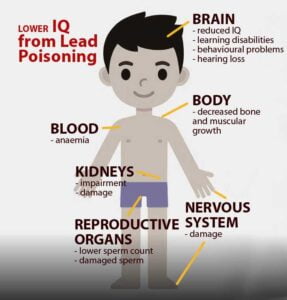Diseases associated with bad water have two sources: biological and chemical. The first group is associated with bacteria and viruses that may be present in drinking water. The second group are diseases caused by toxins of chemical origin, e.g. lead, that enter the water from various industrial sources.
Water readily carries contaminants
Because water is a great solvent (it dissolves more than 2,500 of the known chemical compounds), it is easily contaminated in this way. The treatment of water in waterworks does not ensure its complete chemical purity. Nor can we detect 97% of such contaminants organoleptically using our senses. The most dangerous situation is when the human body cannot get rid of a toxin and accumulates it. Lead accumulates in the bones, liver and brain while aluminum accumulates in the brain, kidneys and bones. In addition, mercury is stored in the kidneys and pituitary gland while chlorine get deposited in the breast tissue of women. So what diseases can threaten us?
Water treatment plants can harm
Already during the process of water treatment in sewage treatment plants, harmful chemical compounds get into the water. Chlorine, used for disinfection, forms new compounds with those previously dissolved in water. These compounds are often carcinogenic. Aluminum, on the other hand, used in the form of ferrous-aluminum sulfate in the coagulation of water, can lead to Alzheimer’s disease.
Lead

Lead, which is a dangerous heavy metal, enters the water supply through road traffic, industry and fertilizers. Its effects are serious and far-reaching. Lead is responsible for mental disorders and even mental illness. Accumulation of lead in the body contributes to lower intelligence, aggression, hypersensitivity, slowed reactions, hearing loss and problems with concentration, balance and growth. Moreover, lead can cause cancer, especially, of the kidneys, stomach and genitals as well as a number of other ailments. Above all, it is particularly dangerous to children. Read more about consequences of lead exposure on children.
Pesticides
Pesticides, used by farmers to control crop pests, enter the water supply with agricultural wastewater and seep into groundwater. Like lead, these compounds accumulate in the human body, especially, in fatty tissue, the liver and the brain. Some are carcinogenic and most harm the nervous and immune systems and liver function. Moreover, they reduce fertility, particularly, in women. Phthalates, chemicals present in tap water that are a component of most plastics, have a similar effect. They can lead to decreased fertility in both men and women.
Conclusion
The chemical compounds found in our drinking water are thoroughly dissolved in it and cannot be detected by the senses. At the same time, they can accumulate in the body and lead to many diseases. The only way to remove them from tap water is through reverse osmosis.

